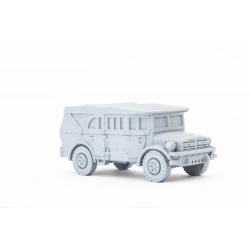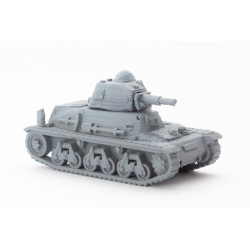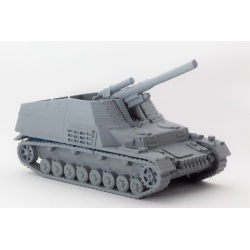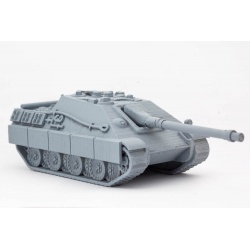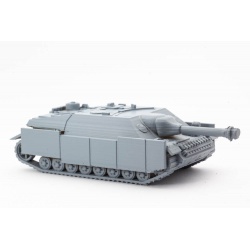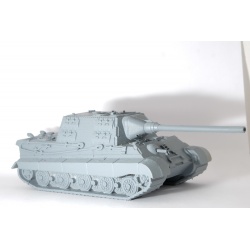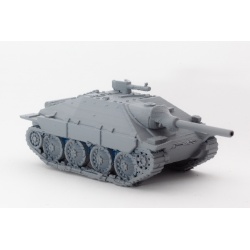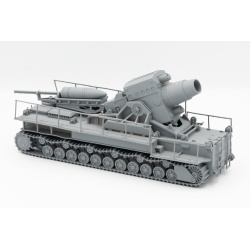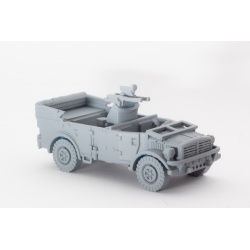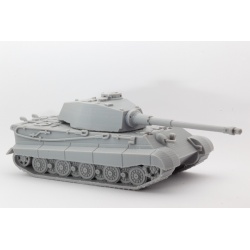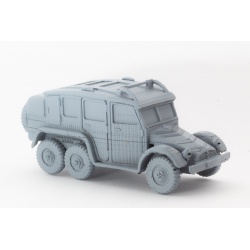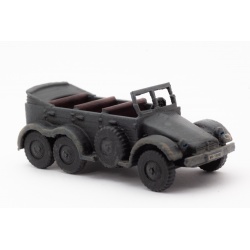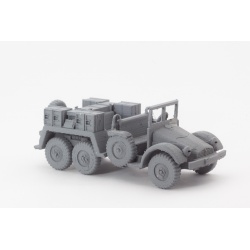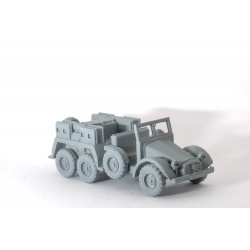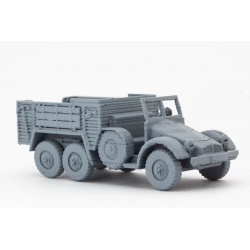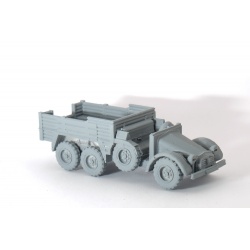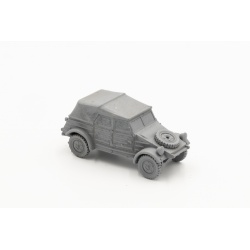Germany
Hotchkiss H35
Model comes n two parts; Hull & Turret.
The Hotchkiss H35 saw service from 1935 until 1952 and appeared in The Israeli War of Independece as well as WWII. It was used by France, Poland, Bulgaria, Hungary as well as Nazi Germany and some other nations.
Weighing 11 tons it featured a37mm SA 18 gun and a 7.5 mm MAC31 Reibel coaxial machine gun.
About 550 vehicles were captured and used by the Germans who redsignated them as either Panzerkampfwagen 35H 734(f) or Panzerkampfwagen 38H 735(f). Around 1200 were built.
The Hotchkiss H35 saw service from 1935 until 1952 and appeared in The Israeli War of Independece as well as WWII. It was used by France, Poland, Bulgaria, Hungary as well as Nazi Germany and some other nations.
Weighing 11 tons it featured a37mm SA 18 gun and a 7.5 mm MAC31 Reibel coaxial machine gun.
About 550 vehicles were captured and used by the Germans who redsignated them as either Panzerkampfwagen 35H 734(f) or Panzerkampfwagen 38H 735(f). Around 1200 were built.
French Light Tank
Hotchkiss H39
Model comes n two parts; Hull & Turret.
The Hotchkiss H39 was an update of the H35. It was very similar, with the same gun but had a new engine and was slightly faster with a longer range.
It was armed with a 37 mm SA 18 gun and a 7.5 mm MAC31 Reibel coaxial machine gun. Prior to 1940 it was armed with the shorter barrel but the version depicted here has the longer barrel.
Around 1200 were produced between September 1936 and June 1940. It served in several armies including France, Poland, Bulgaria, Hungary, Croatia & Yugoslavia.
The Hotchkiss H39 was an update of the H35. It was very similar, with the same gun but had a new engine and was slightly faster with a longer range.
It was armed with a 37 mm SA 18 gun and a 7.5 mm MAC31 Reibel coaxial machine gun. Prior to 1940 it was armed with the shorter barrel but the version depicted here has the longer barrel.
Around 1200 were produced between September 1936 and June 1940. It served in several armies including France, Poland, Bulgaria, Hungary, Croatia & Yugoslavia.
Char léger modèle 1935 H modifié 39
Hummel
Model comes as one part.
The Hummel was a German self propelled gun used between 1943 and 1945.
It weighed 24 tonnes and was based on the Stug III chassis. Around 714 were built. It was armed with a 15cm sFH 18/1 L/30 howitzer.
It was operated by a driver and 5 gun crew.
The Hummel's first major combat was during the Battle of Kursk when 100 took part.
The Hummel was a German self propelled gun used between 1943 and 1945.
It weighed 24 tonnes and was based on the Stug III chassis. Around 714 were built. It was armed with a 15cm sFH 18/1 L/30 howitzer.
It was operated by a driver and 5 gun crew.
The Hummel's first major combat was during the Battle of Kursk when 100 took part.
Panzerfeldhaubitze 18M auf Geschützwagen III/IV (Sf) Hummel, Sd.Kfz. 165
Jagdpanzer IV
This model comes as one part.
The Jagdpanzer was a German tank destroyer based on the Panzer IV chassis. It weighed 25.8 tonnes and had a 7.5cm Pak 42 L70 gun with a 7.92mm MG34 machine gun.
It was crewed by four, driver, commander, gunner and loader.
Around 2,000 were produced between December 1943 and April 1945.
They were utilised by ant-tank sections of Panzer & SS Panzer divisions and saw action at Normandy, the Battle of the Bulge and on the Eastern Front.
The Jagdpanzer was a German tank destroyer based on the Panzer IV chassis. It weighed 25.8 tonnes and had a 7.5cm Pak 42 L70 gun with a 7.92mm MG34 machine gun.
It was crewed by four, driver, commander, gunner and loader.
Around 2,000 were produced between December 1943 and April 1945.
They were utilised by ant-tank sections of Panzer & SS Panzer divisions and saw action at Normandy, the Battle of the Bulge and on the Eastern Front.
Sd.Kfz 162
Jagdtiger
Model comes as one part.
The 71 tonne Jagdtiger was the heaviest operational armoured fighting vehicle of WWII.
It was armed with a 128mm Pak 44 L55 gun and an MG34 or 42 machine gun. It was produced in 1944 and 1945 and under 90 were built.
It served with two heavy anti-tank battalions, the 512th and 653rd.
The 71 tonne Jagdtiger was the heaviest operational armoured fighting vehicle of WWII.
It was armed with a 128mm Pak 44 L55 gun and an MG34 or 42 machine gun. It was produced in 1944 and 1945 and under 90 were built.
It served with two heavy anti-tank battalions, the 512th and 653rd.
Panzerjäger Tiger Ausf. B
Jagpanzer 38(t) Hetzer
Model comes as one part.
The Hetzer was a German tank destroyer base don the Czechoslovakian 38t chassis, which had to be widened and lengthened to accommodate the new hull.
2,827 units were built between March 1944 and May 1945 and they were used by Germany, Hungary and Czechoslovakia.
Weighing in at some 15.75 tonnes, the vehicle was armed with a 7.5cm Pak 39 L/48 gun and a 7.93mm MG34 and was operated by a crew of four.
The Hetzer was a German tank destroyer base don the Czechoslovakian 38t chassis, which had to be widened and lengthened to accommodate the new hull.
2,827 units were built between March 1944 and May 1945 and they were used by Germany, Hungary and Czechoslovakia.
Weighing in at some 15.75 tonnes, the vehicle was armed with a 7.5cm Pak 39 L/48 gun and a 7.93mm MG34 and was operated by a crew of four.
Karl Gerat
Model comes in six parts. (resin)
The Karl Gerat was a self propelled siege mortar. It could fire a 60mm shell, weighing 4,780lb, over 6.2 miles.
Each unit had to be accompanied by a crane to load the ammunition and several modified tanks to carry the shells.
Seven were built and six of them saw action between 1941 and 1945 in Russia/Ukraine, Poland and at Remagen and the Battle of the Bulge.
Note: This is a large model measuring around 190mm by 70mm and weighs around 240 grams (resin)
The Karl Gerat was a self propelled siege mortar. It could fire a 60mm shell, weighing 4,780lb, over 6.2 miles.
Each unit had to be accompanied by a crane to load the ammunition and several modified tanks to carry the shells.
Seven were built and six of them saw action between 1941 and 1945 in Russia/Ukraine, Poland and at Remagen and the Battle of the Bulge.
Note: This is a large model measuring around 190mm by 70mm and weighs around 240 grams (resin)
German Siege Mortar
Kfz 81 Horch 108 Zwilling Lafette
Model comes as 2 parts; Car and Gun.
The Horch came in light, medium and heavy versions and had a number of uses. The model depicted here is the heavy version which was fitted with an anti-aircraft gun.
Over 5,000 of all versions were built.
The Horch came in light, medium and heavy versions and had a number of uses. The model depicted here is the heavy version which was fitted with an anti-aircraft gun.
Over 5,000 of all versions were built.
Heavy Car with AA
Krupp Protze Kfz 19
This model comes in one part.
The Krupp Protze was a German truck and artillery tractor made between 1934 and 1941. It came in several designations such as Kfz.19 - Telephone Truck, Kfz.21 - Staff car, Kfz.68 - Radio Truck, Kfz.69 - Artillery Tow, Ammo or Generator Carrier (Kfz.81 or 83) etc. The one here is the Kfz.19.
The Kfz.19 was a radio or telephone communications vehicle.
The Krupp Protze was a German truck and artillery tractor made between 1934 and 1941. It came in several designations such as Kfz.19 - Telephone Truck, Kfz.21 - Staff car, Kfz.68 - Radio Truck, Kfz.69 - Artillery Tow, Ammo or Generator Carrier (Kfz.81 or 83) etc. The one here is the Kfz.19.
The Kfz.19 was a radio or telephone communications vehicle.
Fernsprech-Betriebskraftwagen
Krupp Protze Kfz 21 Staff Car
This model comes in one part.
The Krupp Protze was a German truck and artillery tractor made between 1934 and 1941. It came in several designations such as Kfz.19 - Telephone Truck, Kfz.70 - Personnel Carrier, Kfz.68 - Radio Truck, Kfz.69 - Artillery Tow, Ammo or Generator Carrier (Kfz.81 or 83) etc. The one here is the Kfz.21 - Staff Car
7,000 were built and they saw action on the Eastern Front, North Africa, France & Italy.
(please note, due to the nature of the design, the model may not have a steering wheel as the printing process makes it very difficult to model that feature)
The Krupp Protze was a German truck and artillery tractor made between 1934 and 1941. It came in several designations such as Kfz.19 - Telephone Truck, Kfz.70 - Personnel Carrier, Kfz.68 - Radio Truck, Kfz.69 - Artillery Tow, Ammo or Generator Carrier (Kfz.81 or 83) etc. The one here is the Kfz.21 - Staff Car
7,000 were built and they saw action on the Eastern Front, North Africa, France & Italy.
(please note, due to the nature of the design, the model may not have a steering wheel as the printing process makes it very difficult to model that feature)
Krupp Protze Kfz 69
This model comes in one part.
The Krupp Protze was a German truck and artillery tractor made between 1934 and 1941. It came in several designations such as Kfz.19 - Telephone Truck, Kfz.21 - Staff car, Kfz.68 - Radio Truck, Kfz.69 - Artillery Tow, Ammo or Generator Carrier (Kfz.81 or 83) etc.
7,000 were built and they saw action on the Eastern Front, North Africa, France & Italy.
The Kfz 69 was an artillery tow version often used to tow a Pak 36 AT gun.
(please note, due to the nature of the design, the model may not have a steering wheel as the printing process makes it very difficult to model that feature)
The Krupp Protze was a German truck and artillery tractor made between 1934 and 1941. It came in several designations such as Kfz.19 - Telephone Truck, Kfz.21 - Staff car, Kfz.68 - Radio Truck, Kfz.69 - Artillery Tow, Ammo or Generator Carrier (Kfz.81 or 83) etc.
7,000 were built and they saw action on the Eastern Front, North Africa, France & Italy.
The Kfz 69 was an artillery tow version often used to tow a Pak 36 AT gun.
(please note, due to the nature of the design, the model may not have a steering wheel as the printing process makes it very difficult to model that feature)
Heavy car
Krupp Protze Kfz 69 (v.2)
This model comes in eight parts.
The Krupp Protze was a German truck and artillery tractor made between 1934 and 1941. It came in several designations such as Kfz.19 - Telephone Truck, Kfz.21 - Staff car, Kfz.68 - Radio Truck, Kfz.69 - Artillery Tow, Ammo or Generator Carrier (Kfz.81 or 83) etc.
7,000 were built and they saw action on the Eastern Front, North Africa, France & Italy.
The Kfz 69 was an artillery tow version often used to tow a Pak 36 AT gun.
This is an alternative version to another Kfz 69 we produce.
The Krupp Protze was a German truck and artillery tractor made between 1934 and 1941. It came in several designations such as Kfz.19 - Telephone Truck, Kfz.21 - Staff car, Kfz.68 - Radio Truck, Kfz.69 - Artillery Tow, Ammo or Generator Carrier (Kfz.81 or 83) etc.
7,000 were built and they saw action on the Eastern Front, North Africa, France & Italy.
The Kfz 69 was an artillery tow version often used to tow a Pak 36 AT gun.
This is an alternative version to another Kfz 69 we produce.
German Heavy Car
Krupp Protze Kfz 70
This model comes in one part.
The Krupp Protze was a German truck and artillery tractor made between 1934 and 1941. It came in several designations such as Kfz.19 - Telephone Truck, Kfz.21 - Staff car, Kfz.68 - Radio Truck, Kfz.69 - Artillery Tow, Ammo or Generator Carrier (Kfz.81 or 83) etc. The one here is the Kfz.70 - Personnel Carrier.
7,000 were built and they saw action on the Eastern Front, North Africa, France & Italy.
(please note, due to the nature of the design, the model may not have a steering wheel as the printing process makes it very difficult to model that feature)
The Krupp Protze was a German truck and artillery tractor made between 1934 and 1941. It came in several designations such as Kfz.19 - Telephone Truck, Kfz.21 - Staff car, Kfz.68 - Radio Truck, Kfz.69 - Artillery Tow, Ammo or Generator Carrier (Kfz.81 or 83) etc. The one here is the Kfz.70 - Personnel Carrier.
7,000 were built and they saw action on the Eastern Front, North Africa, France & Italy.
(please note, due to the nature of the design, the model may not have a steering wheel as the printing process makes it very difficult to model that feature)
Krupp Protze Kfz 70 (v.2)
This model comes in eight parts.
The Krupp Protze was a German truck and artillery tractor made between 1934 and 1941. It came in several designations such as Kfz.19 - Telephone Truck, Kfz.21 - Staff car, Kfz.68 - Radio Truck, Kfz.69 - Artillery Tow, Ammo or Generator Carrier (Kfz.81 or 83) etc. The one here is the Kfz.70 - Personnel Carrier.
7,000 were built and they saw action on the Eastern Front, North Africa, France & Italy.
This is an alternative version to another Kfz 70 we produce.
The Krupp Protze was a German truck and artillery tractor made between 1934 and 1941. It came in several designations such as Kfz.19 - Telephone Truck, Kfz.21 - Staff car, Kfz.68 - Radio Truck, Kfz.69 - Artillery Tow, Ammo or Generator Carrier (Kfz.81 or 83) etc. The one here is the Kfz.70 - Personnel Carrier.
7,000 were built and they saw action on the Eastern Front, North Africa, France & Italy.
This is an alternative version to another Kfz 70 we produce.
German Heavy Car
Kubelwagen (v1)
This model comes in one part.
There can be few people who have't heard of the Kubelwagen, designed by VW. Over 50,000 Kubelwagens were produced between 1940 and 1945.
The model depicted here has the roof up, a bonus as you don't have to find any crew for it!
There can be few people who have't heard of the Kubelwagen, designed by VW. Over 50,000 Kubelwagens were produced between 1940 and 1945.
The model depicted here has the roof up, a bonus as you don't have to find any crew for it!
4-door roadster
Kubelwagen (v2)
Model comes in 10 parts (resin is one part)
There can be few people who have't heard of the Kubelwagen, designed by VW. Over 50,000 Kubelwagens were produced between 1940 and 1945.
The model depicted here has the roof up, a bonus as you don't have to find any crew for it!
This is a different version of the Kubel which has been on the site for several years
Please note: Photo is of a resin print
There can be few people who have't heard of the Kubelwagen, designed by VW. Over 50,000 Kubelwagens were produced between 1940 and 1945.
The model depicted here has the roof up, a bonus as you don't have to find any crew for it!
This is a different version of the Kubel which has been on the site for several years
Please note: Photo is of a resin print
German Car
Kubelwagen (v3)
Model comes as one part.
This model comes in one part.
There can be few people who haven't heard of the Kubelwagen, designed by VW. Over 50,000 Kubelwagens were produced between 1940 and 1945.
Please note: This model is in resin only and may not be available at the smaller scales.
This model comes in one part.
There can be few people who haven't heard of the Kubelwagen, designed by VW. Over 50,000 Kubelwagens were produced between 1940 and 1945.
Please note: This model is in resin only and may not be available at the smaller scales.
German Jeep


